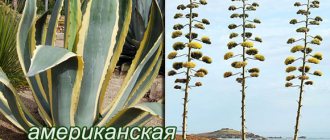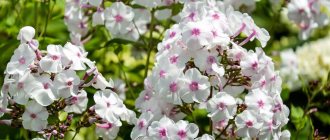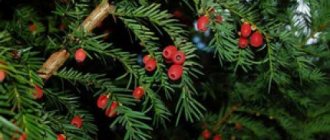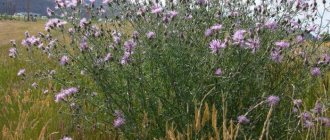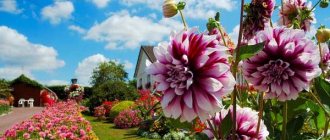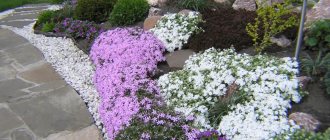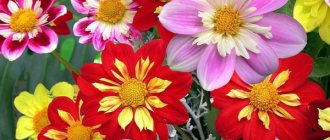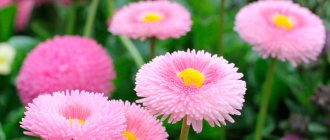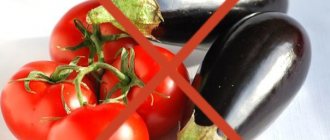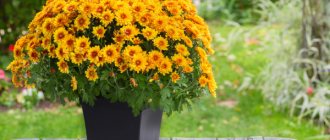Carnation is a beautiful perennial flowering plant that belongs to the flowering department, dicotyledonous class, order Cloveaceae, family Cloveaceae, genus Dianthus (lat. Dianthus).
The Latin name for this genus of ornamental plants was assigned by Carl Linnaeus. He formed it from two Greek words: “δῖος”, corresponding to the concept of “divine”, and “anthos”, meaning flower. As a result, the name translates as “divine flower” or “flower of Zeus” (Jupiter). The word “clove” appeared in the Russian lexicon thanks to a loose reading of the Polish definition of a plant (goździk), which was borrowed from the German language and meant a clove tree (Gewürznelken). The aroma of the flower is very similar to the spicy smell of its dried buds.
Despite the great diversity of species, all carnation flowers included in the genus have similar characteristics. Although most carnations are a perennial plant, they are most often cultivated as an annual or biennial.
The structure of the clove root system depends on the species. It can be taproot with deep germination of the central root, taproot branched or fibrous with roots buried to a depth of no more than 20 cm.
These plants are characterized by the simultaneous development of vegetative and flowering shoots with characteristic nodular thickenings. The leaves of the carnation are located oppositely on the stems and have a linear, linear-lanceolate or subulate shape. In old perennial plants, over time, lignification of the lower parts of the stems is observed, as a result of which it becomes similar to a subshrub. In the upper part the shoots often branch. The height of the carnation ranges from 15 cm to 75 cm.
Typically, the plant is characterized by the presence of one carnation flower on the stem, which consists of 5 petals having a horizontal plate with a jagged or fringed outer edge and a long nail.
There are types of carnations that have several small flowers collected in umbellate, paniculate or corymbose inflorescences. In many carnations, the base of the plate is covered with thin hairs that form a kind of beard.
The color of carnation petals can be red, burgundy, white, pink, and sometimes lavender. There are varieties of carnations in which the petal blade is colored green, purple or orange.
In addition to plants with simple flowers, there are double and semi-double carnations. The calyx of the flower, covered with several pairs of bracts, has a cylindrical or cylindrical-conical shape.
The fruit of the clove is a small elongated capsule with a large number of small, flat, oblong-rounded black seeds. Once ripe, it opens at the top and the clove seeds spill out onto the ground.
Carnation Sandy
Homeland - Europe, Ciscaucasia. Refers to ground-blooded plants for dry, sunny places, this is a perennial herbaceous plant of the carnation family with branched, creeping stems ascending at the base, bluish or greenish in color. The leaves are small, linear, sickle-shaped or narrow-lanceolate, green in color.
The flowers are solitary, with fringed edges, large, with a pleasant, delicate aroma. Flower petals are white, less often pinkish. Peduncles are simple or branched, the height of which is from 10 to 30 cm.
Sandy Carnation blooms from mid-June to the end of July. The fruit is a multi-seeded capsule, the seeds are flat, black, ripen in August. Sandy Carnation is propagated by seeds. Refers to light-loving plants; for cultivation, the soil should be light, dry, sandy.
Sandy carnation forms a dense, bluish-green, herbaceous carpet. Its height reaches 5-10 cm. The plant is planted in open sunny places, in rocky gardens, rock gardens, forest edges and clearings.
Site selection and soil preparation
An inhabitant of dry hills, carnation grass prefers dry areas exposed to the sun. When placed in a flower garden, low bushes are positioned so that they are not shaded by larger plants. Diffused partial shade from a dwarf birch or pine tree in the midday heat is acceptable. In deep shade, the carnation will bloom poorly and develop poorly.
The species is grown as a perennial crop. For planting single seedlings or separate groups, it is advisable to prepare planting holes. Continuous preparation of an entire area is carried out if it is intended to decorate a border or create a carpet of ground cover varieties.
Grass grows well on light porous substrates; limestone or sandy soils are optimal. It is unacceptable to plant plants on acidic, clayey, low-lying soils with stagnant water. Such land is first cultivated - water is drained, sand mixed with ground shell rock is added, and acidic soils are limed.
Plants do not need nutritious manure soils and may die if fresh manure is added. For spring planting of seedlings, the site is prepared in the fall or early spring, thoroughly cleared of weeds.
When digging or planting holes, add sand, high-moor peat, and leaf soil to lighten the soil and obtain a breathable structure. To avoid stagnation of water at the roots, drainage made of expanded clay or shell rock is placed at the bottom of the planting holes.
When planting grass on a rocky hill, it is better to allocate a place on the slope rather than at the foot. When decorating paths with flower borders, it is worth stepping back from the edge - ground cover varieties tend to spread out with creeping shoots, and a narrow path can be completely covered with clove “waves”.
Carnation pinnate
Homeland - Western Europe. Refers to ground-blooded plants for dry, sunny places. This perennial is a clove plant, a compact, turfy bush with an erect, angular, bluish-green stem. Plant height – 20-25 cm.
The leaves are linear, lanceolate, basal in a rosette, bluish-green in color, and remain until spring. The flowers are single, the diameter of which reaches three centimeters with a pleasant aroma, collected in 2-4 inflorescences, located at the ends of the shoots. The flowers are semi-double, double, red, white, purple, pink, have fringed, cut edges.
Carnation pinnate blooms in June-July. The fruit is a seed capsule, the seeds are numerous, flat, black, ripen in August-September. Carnation pinnate is propagated by seeds, dividing the bush, and cuttings. The plant is a frost-resistant, light-loving plant.
The soil for its cultivation should be light, sandy, containing lime, and moderately moist. It grows for 3-5 years without transplantation. They are planted in large groups in flower beds, rock gardens, and rocky gardens.
Carnation Travyanka
Homeland – Eastern, Western Europe. This is a herbaceous perennial, classified as ground-blooded plants for dry, sunny places. Its height is 10-15 cm. The stem of Carnation Grass is branched, has creeping shoots that take root throughout the season.
Small leaves are linear, dark green in color. The few terminal flowers are solitary, fluffy, bright pink or crimson-red.
Dianthus Grass produces clove-like flowers from late May through August. The fruit is a capsule, the seeds are small, black, ripen in August. Carnation pinnate is propagated by seeds. The plant is a frost-resistant, light-loving plant.
Grows well in open sunny places. Tolerates winter without shelter. The plant is not fussy to grow. The soil should be light, sandy, dry, loose, not acidic. It grows for 4-5 years without transplantation.
Herbaceous carnation forms a dense, beautiful herbaceous carpet up to 10-15 cm high, as a result of which it is a decoration for rock gardens and rocky gardens.
History, legends about carnations
The earliest information about cloves is found in the myths of Ancient Greece, after which mention of it disappears for 12 centuries. Some historians believe that it was the Crusaders who first brought the flower to Europe as a cure for the plague and a symbol of victory. During Napoleon's time, the color of the carnation was chosen for the ribbon of the Legion of Honor.
European artists of the 16th century made carnations an integral part of portraits and still lifes. The flower is mentioned in Shakespeare's play The Winter's Tale. Queen Elizabeth introduced the fashion for carnations in England.
Bouquet of carnations
The carnation is one of the symbols of the Soviet era. Soviet citizens carried red bouquets to demonstrations dedicated to the day of the October Revolution. For more than 70 years in the CIS countries, the carnation has remained a symbol of victory in the Great Patriotic War.
Gypsophila creeping
Homeland - Southern Europe. Refers to ground-blooded plants growing in dry, sunny places. This is a perennial, herbaceous plant of the clove family, whose height is 10-15 cm, and has shoots creeping along the ground.
The leaves are narrowly lanceolate or narrowly linear, dark green in color. Numerous small white and pink flowers form paniculate, airy inflorescences. Gypsophila creeping blooms in June-July.
The fruit is a capsule, the seeds are sharply tuberculate, black, ripen in August. Gypsophila creeping is propagated by seeds and cuttings. Refers to frost-resistant, light-loving plants.
To grow it, the soil must be light, sandy loam, well drained, and contain lime. It grows for 4 years without transplantation. Gypsophila creeping is planted in borders, rock gardens, rocky gardens, and rockeries.
Yaskolka Serebristaya
Homeland - Caucasus. A winter-green perennial, whose height is 20-25 cm, it belongs to the ground-blooded plants of the carnation family for dry, sunny places. It has numerous, creeping, easily rooted stems.
The leaves are numerous, linear, oblong, bluish-green in color. All terrestrial organs of the Serebrysta have a continuous white-tomentose pubescence, which gives the plant a silvery color. Large flowers are silver-white, collected in inflorescences that look like loose semi-umbrellas.
The plant blooms in early June for a month. The fruit is an oblong capsule, the seeds are kidney-shaped, brown in color, ripen in July-August. Propagation of the silver lily is by seeds and rooted parts of the stem.
Refers to frost-resistant, light-loving, drought-resistant plants. Not demanding on growing conditions. Any soil is suitable; it grows without replanting for 5-6 years. Yaskolka Silver is planted in rocky gardens and to decorate silvery lawns in sunny areas.
Carnations in landscape design
Variegated Chinese and Turkish carnations go well with other flowers in neutral monochrome shades.
Variety Eydangeri
Some useful tips for flower neighbors:
- Roses inhibit the growth of carnations, so flowers are not planted nearby. Arrange them only in cut form.
- It is not recommended to plant carnations next to tulips, since the plants are susceptible to the same diseases.
- Stagnation of moisture in the soil is contraindicated for the crop. Do not plant carnations in low-lying areas or wetlands.
- If you are choosing a low-growing species, choose grass or sand. Low-growing bushes do not exceed 25 cm during the flowering period.
- In a sunny area, the flower will bloom more abundantly and develop faster than in a shaded flowerbed.
- To design a rock garden or rock garden, plant perennial pinnate varieties.
A skillfully selected variety will harmonize well with plants of any type
Bright varieties of Turkish carnations look good next to tall shrubs, without fear of shading.
Yaskolka Felt
Homeland - Central and Southern Italy. The perennial has a low, dense bush, the height of which is 10-12 cm, and is classified as ground-blooded plants for dry, sunny places. The bush is formed due to numerous thin, branched stems creeping along the ground.
The leaves are small, linear-lanceolate, silver-gray in color, and quite densely located on the stem. The shoots and leaves of Yaskolka Voylochnaya tolerate winter well without shelter. Small, single flowers up to 1 cm in diameter, white, bell-shaped.
The plant blooms in May for a month. The fruit is a capsule, the seeds are small, slightly flattened, brown-black in color, ripen in July-August. This clove plant is propagated by seeds, dividing the bush, and cuttings. Yaskolka Felt is a frost-resistant, light-loving, drought-resistant plant.
The soil for its cultivation should be light, sandy, and well fertilized. It grows for 5 years without transplantation. The resulting colorful cover of Yaskolka Felt is used to decorate lawns in sunny areas and for rock gardens.
Jaskolka Bieberstein
Homeland - Crimea. Bieberstein's berry is called Alpine edelweiss and is listed in the Red Book of Ukraine. This is a densely white-tomentose perennial, whose height is 20-25 cm, and belongs to ground-blooded plants for dry, sunny places.
The plant has creeping, erect, densely leafy shoots. Sessile leaves are linear or oblong-linear, opposite leaves are linear-lanceolate, green. The flowers, up to 1.5 cm in diameter, are white, collected in inflorescences, which are a few-flowered, loose semi-umbrella. Inflorescences are located at the tops of the shoots.
Bieberstein's Carnation begins to produce carnation-like flowers in late April to May. The fruit is a capsule, the seeds are not large, black, ripen in June. The plant is propagated by seeds and cuttings. Bieberstein's sprout is a frost-resistant, light-loving, drought-resistant plant.
To grow it, the soil must be light, dry, and well fertilized. Grows without transplantation for 4-5 years. Planted for decoration of rock gardens and rocky gardens.
Description
The plant is a low herbaceous bush with a short but widely branched root system.
The slightly pubescent, rigid stems are divided into two types. Vegetative ones, or those that do not produce flowers, reach a height of up to twenty centimeters and bear abundant foliage. Flowering shoots are longer, up to forty centimeters, branch at the top into two or three shoots and are crowned with flowers.
Leaves of narrow and long shape are basal and stem. The first ones are larger, the second ones are smaller, up to three millimeters wide, and have jagged edges. As they grow, their color changes from bluish-green to bright green.
Five-petalled flowers can have bright red, pink, white colors, and even a mixture of them, different for different varieties. They form small inflorescences, growing at the tops of the branching parts of the flowering shoot. The size of the flowers reaches two centimeters in diameter.
Some flowers have pedicels up to three centimeters long. The edges of the petals are smooth or finely jagged. A peculiarity of the species is the presence of a cup in the form of a ring at the base of the petals, a darker color than the petals themselves. For carnation grass, the flowering period begins in mid-summer and lasts on average forty-five days, until the beginning of autumn.
At the end of the flowering period, a fruit appears on the plant, which is a small box with a large number of very small seeds.
After ripening, the capsule bursts, allowing the bush to reproduce well by self-seeding.
Kinds
The plant has been cultivated by flower growers for centuries. During this time, many varieties of grass carnation have appeared, some of which are especially decorative and unpretentious.
Here are just a few:
- Shabot. A perennial bush with double inflorescences consisting of large flowers of different colors. It is distinguished by original flowers, the petals of which form unusually shaped buds with wavy edges, as well as a wonderful smell.
- Dutch garden. A perennial hybrid with a very long flowering period, beginning in mid-summer and ending in late autumn.
- Cirrus. A perennial small, compact, but dense bush with double flowers of different colors.
- The flowering period continues throughout the summer.
- Turkish. Unpretentious perennial bushes with inflorescences consisting of large flowers, painted in different color combinations.
It will be interesting to read about Ifeyon: cultivation features and varieties.
Lychnis, Zorka
Homeland - temperate zones of the Northern Hemisphere, a herbaceous plant of the carnation family, belonging to ground-blooded plants, up to 40 cm high. They have erect, round, weakly branched, rough stems that die off annually.
The leaves are opposite, linear-ovate, dark green above and light green below. Flowers of both sexes are collected in loose, corymbose inflorescences located at the ends of the stems, pink, bright red, purple, and cream in color. There are varieties Lychnis and Zorki with double flowers.
Lychnis and Zorka bloom in June-July. The fruit is a capsule, the seeds are kidney-shaped, dark brown in color, ripen in August. The plant is propagated by seeds and cuttings. Frost-resistant plant, tolerates winter without shelter, light-loving but can also grow in shaded places.
The soil for growing should be sandy, well-drained, deeply cultivated, fertilized, and not waterlogged. Planted in groups in parks, rock gardens, rock gardens, mixborders, borders.
Three species are used in culture: Lychnis Chalcedony - bright red flowers, Lychnis Sparkling - fiery red flowers, Lychnis Hage - red or orange flowers.
Growing weed in a pot
There are no varieties of indoor carnations; they are all designed for growing in the garden and open ground. However, some types of this crop can be used for growing at home.
Carnation grass is not grown in flowerpots. This variety is ground cover, so it cannot be replanted or subjected to other manipulations.
Gardening specialists recommend using Chinese cloves, as well as the Grenadine, Shabo and Heddeviga varieties for these purposes.
Saginah, Bryozoan
Distributed in temperate and cold zones of Europe. It is an evergreen, turfy perennial that resembles moss as the plants cover the soil in small pads that are about 5cm high with creeping, branched stems. Refers to ground-blooded plants for shady and semi-shady areas.
The leaves are small, miniature, needle-shaped or linear, green in color, but there are plants with yellow leaves. The flowers are single, small, white, with a delicate delicate aroma, located on elongated peduncles, up to 20 cm.
Sagina blooms in July-August, the fruit is an oblong-ovoid capsule. The seeds are kidney-shaped, smooth, dark brown in color. The plant is propagated by seeds and small sods. A winter-hardy plant, it grows and develops well in shady and semi-shady areas.
They are not fussy to grow; the soil should be loamy, sandy, and well-drained. Planted in flower beds, ridges, shady and semi-shaded places.
Silena, Smolevka
Homeland - Mediterranean. Herbaceous perennials, cloves, related to ground-blooded plants, the height of which is from 5 to 25 cm, with sticky, erect or recumbent, branched stems.
The leaves are small, opposite, lanceolate, acute-oval in shape, bluish-green in color. The flowers are solitary, five-petalled, star-shaped, white, purple, pink or yellow-greenish in color.
Plants bloom in July-August. The fruit is an ovoid capsule, the seeds are kidney-shaped, dark brown in color, ripen at the end of August. Plants are propagated by seeds and dividing the bush. Frost-resistant, light-loving plants.
They grow and develop well in open sunny areas. In shaded areas, weak flowering and tall, elongated stems are observed, which is why the decorative value of these plants is lost.
The soil for growing should be sufficiently loose, sandy loam, well fertilized, slightly acidic, drained (that is, with the addition of sand and granulated crumbs). Planted in flower beds, ridges, borders, stone gardens and rock gardens.
There are two common types of Silena: Silena stemless - pink flowers and Silena Primorskaya - white flowers.
Saponaria, Soapwort
Distributed in the Mediterranean and is a herbaceous plant of the carnation family, the height of which is 60-100 cm, has numerous, erect, knotty, short-haired or ascending branched stems. Creeping, highly branched, reddish-brown rhizomes, roots and stems contain saponin, which is capable of forming foam.
The leaves are sessile, oblong, oval-lanceolate, light green in color. Flowers up to 5 cm in diameter with a pleasant aroma of white or pink color, are collected in multi-flowered corymbose, paniculate inflorescences.
Saponaria blooms in July-August. The fruit is oblong-ovoid, capsule. The seeds are small, spherical, kidney-shaped, black, and ripen in August-September. Saponaria is propagated by seeds, dividing the bush, and cuttings.
This is a light-loving, frost-resistant plant, unpretentious in cultivation. The soil should be loose, moderately fertilized, with the addition of lime. Drainage, moderately dry. It grows in one place without transplanting for 6-8 years.
Saponaria is planted in group plantings and front gardens; rocky gardens are also used for arranging bouquets.
Summary
Carnation-grass: video
Carnation grass dianthus deltoides red is simply a stunning perennial that has incredibly attractive decorative properties. Very few species of other plants can compete with them, since carnation is an unpretentious, frost-resistant and colorful plant that produces lush shrubs dotted with flowers. They look great both in single plantings and in group compositions. Thanks to so many benefits, the carnation remains an incredibly attractive and significant plant, and will probably remain so for many years to come.
Caring for perennial plants of the Carnation family
High decorativeness and rapid development of perennial plants of the Clove family can be achieved through careful care during their cultivation. It promotes good development of both their root system and the embryonic shoots of plants - stems, cuttings, buds of renewed growth.
Caring for perennial plants of the Clove family consists of the following procedures:
- weeding;
- loosening the soil;
- watering;
- fertilizing with organic fertilizers;
- fertilizing with mineral fertilizers;
- protection against diseases;
- shelter for the winter;
- transfer.
Regular weeding removes weeds while maintaining the water and nutritional regime needed by plants.
Loosening the soil is necessary to maintain moisture and air conditions. Deep loosening must be done during the growing season of plants.
Watering should be especially abundant during the growing season of plants, and then optimal watering to maintain the soil moisture necessary for plants.
Fertilizing with organic fertilizers . In the spring, at the beginning of the growing season, humus, compost, and mullein are added to the soil. This retards the growth of weeds, which disrupt the hydrotechnical regime necessary for plants.
Fertilizing with mineral fertilizers . The first fertilizing is carried out in early spring (when the snow melts) along with loosening the soil. Along with watering, nitrogen fertilizers are added, which are necessary for the development of the plant’s vegetative organs. The second fertilizing (application of phosphorus and potassium fertilizers also during watering) is carried out during the budding period of plants.
Protection from diseases - potassium and phosphorus fertilizers, which are applied during watering in spring and summer, protect plants from fungal diseases.
Shelter for the winter - plants that cannot tolerate low temperatures must be covered for the winter with dry leaves or branches of spruce and pine.
Plants are transplanted to rejuvenate them 4-5-6 years after sowing.
Diseases and pests
Like any crop, garden carnations require preventive measures to ensure normal growth. The main pests include: nematodes, thrips, and mole crickets. The fight against them involves the use of chemicals. When spraying plants, strictly follow the instructions indicated on the preparations.
Viral diseases such as fusarium, alternaria, rust and mottling are dangerous for flowers of this species. The affected plant loses its attractiveness and even dies. The manifestations of these diseases are similar. Brown spots or a bluish coating appear on the leaves and stems. In addition to the listed diseases, garden carnations are affected by the fungus. Care with proper moisture and regular loosening of the soil, removing weeds, limiting nitrogen and using an aqueous solution of basic mineral fertilizers will help reduce the likelihood of disease. A high level of agrotechnical measures in combination with regular fertilizing significantly reduces the level of infection by infectious diseases.
Seed propagation of perennials of the Carnation family
To grow perennial plants of the Clove family, seedling and non-seedling methods of propagating them by seeds are used.
Carnation Grass, Bibberstein's Cleaver, Creeping Gypsophila, Lychnis, Sagina, Saporia are propagated by seedlings The seeds of these plants are sown in March in boxes with well-prepared soil (loose, drained, moderately moist, fertilized) and placed in greenhouses or greenhouses. At a temperature of +18-20 degrees, seedlings appear 6-8 days after sowing. When the first pair of true leaves appears, the plants dive at a distance of 4-6 cm.
Plants are planted in well-prepared open ground in August at a distance of 20-30 cm from each other. For the winter, the plant is covered with fallen dry leaves, peat chips, sawdust, and spruce branches. The plants bloom the following year in the summer.
In the seedless method , that is, by seeding seedlings in open ground, the following are propagated: Felt lily, Silver lily, Pinnate carnation, Sandy carnation, Lychnis, Silena. The optimal time for sowing these plants in well-prepared soil is mid-May. By autumn, the height of the plants is already about 8-9 cm. Good development of 50 to 100 shoots is also observed.
For the winter, the plant is covered with dry leaves, peat chips, sawdust, and spruce branches. The plants bloom the following year in the summer and bloom profusely throughout the month.
Reproduction by cuttings
All types of perennial carnations are propagated by cuttings; this method is not suitable for annual plants. Cuttings are selected from among well-developed vegetative shoots at the end of May. The length of the cutting should be from 3-9 cm, and the shoot should have at least 6 healthy leaves.
Cuttings of eustoma and carnation
The shoot is cut from the stem under the node using a sharp pruner and the leaves are removed from its lower part. An incision is made along the stem.
The cuttings are placed in a pot with perlite and covered with a jar. If the greenhouse is made correctly, rooting will occur within 3 weeks after planting. Next, you need to prepare a container with calcined sand or perlite and plant the cuttings in it.
Vegetative propagation of plants of the Carnation family
Every year we observe the growth, sometimes abundant flowering and fruiting of perennial plants of the clove family. This development occurs due to those parts of strong plants that have withstood the harsh winter well. The methods of vegetative propagation of these plants are as follows:
- dividing the bush;
- cuttings;
- stems.
By dividing the bush they propagate : Dianthus pinnata, Carnation tomentosa, Saponaria, Silena. The division of the bush is carried out at the end of August - the first half of September. It is necessary that the divided parts of the plant contain growth buds, embryonic shoots and roots, since they contain nutrients.
Propagated by cuttings : Dianthus pinnata, Creeping gypsophila, Bieberstein's carnation, Saponia, Lychnis. For this purpose, summer stem cuttings and those obtained from vegetative or apical shoots are used. Plants are cut from May-June.
The rooted stems are used to propagate Silverback.
Divided parts of the bush, weakly rooted stems and cuttings are planted for growing for a year, that is, to achieve the established conditions. They are planted in boxes with light sandy loam, nutritious, well-drained soil and placed in panics or greenhouses.
Without growing, the decorative effect will not be achieved, because the flowering of these plants is delayed. All this time, caring for the plants consists of fertilizing, loosening the soil, weeding and maintaining an optimally moist state of the soil. A year later, the plants are planted in a permanent place in late August - early September.
Reproduction by layering and dividing the bush
The method is suitable for propagation of large species.
A longitudinal incision is made at the internode of strong lower shoots, the shoot is bent to the ground and rooted with the incised area. The cuttings are sprinkled with soil and watered. Once roots appear, the plant can be separated and replanted.
Schematic representation of the process
Reproduction by dividing the bush is suitable only for some species, such as Turkish and pinnate.
